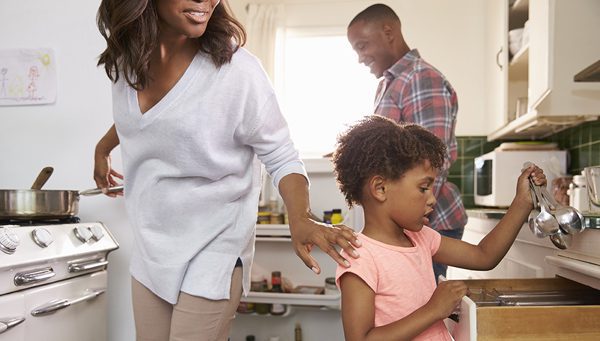
For the last ten years, as a family therapist and co-founder of The Family Dinner Project, I’ve talked to hundreds of families about their dinners. Most parents know about the scientifically proven academic, nutritional, and emotional benefits of regular family dinner— higher-grades and bigger vocabularies, greater resilience and better nutrition, as well as lower rates of depression, substance abuse and obesity. But I’ve been struck by how often parents wonder if their dinners are “good enough” to get these benefits. Here are some of the questions I’m most often asked about what really “counts” as a family dinner:
What if only one parent is home for dinner?
A ten-year-old boy whose father was deployed to Iraq asked me at a Family Dinner Project Community Dinner at the Hanscom Air Force Base, “Does it count as family dinner with my father away?” I told him emphatically, “Of course! It’s a family dinner with you and your mother at the table.” As long as there are two family members eating together, experiencing connection, and enjoying one another, that is a family dinner. The adult could be an aunt, grandfather, or another caregiver.
What if it’s take-out?
If the meal is eaten with others at the table, talking about their day or anything else on their minds, it’s a family dinner. A take-out dinner may not have the same nutritional value as a home-cooked meal because restaurant food tends to be higher in fat, salt, and sugar. But remember: the food is secondary. The benefits of family dinner don’t derive from a home-cooked roast chicken with a side of heirloom tomatoes. The mental health and academic benefits in particular flow from what happens at the table once the food arrives. If the atmosphere is warm and welcoming, if children are encouraged to talk and then feel that what they have to say is worth listening to, this is what matters.
What if we can only pull off having dinner once a week? Should we just forget about it?
No! Often, when families have one great meal or one “good enough” meal, they find that they want to have more of them. Several studies do suggest that there is a sweet spot of 5 mealtimes a week that yield the greatest benefits in nutritional and emotional health. That said, one dinner a week that your family looks forward to, where everyone pitches in to cook, clean up and talk at the table, is worth a dozen meals with raised voices or stony silence. Even one positive dinner a week can be very beneficial to both kids and adults.
Does it have to be dinner?
No, it doesn’t! In any average week, there are at least sixteen possible times for families to eat together: seven breakfasts, seven dinners, and two weekend lunches. In addition, a nighttime snack when you and your kids take a break together, eat fruit, and sip hot chocolate or a cup of tea is another chance to connect and enjoy one another. The goal is not to achieve a magic number. The goal is to find as many opportunities as you can and to make the most of them. Any meal or intentional snack can count.
What if the TV is on?
Research suggests that kids tend to eat more calories and fewer fruits and vegetables when the TV is on. And when the TV is on, or when family members are constantly checking their gadgets, it detracts from everyone feeling that they are important and worth listening to. If you and your family occasionally watch a TV program during dinner (such as a special event) or watch the news together, that can be a natural opportunity to spark conversation beyond the usual report of the day. And devices can aid conversation when family members share a funny text, a startling photo, or an embarrassing email.
I don’t have any children. What do family dinners have to do with me?
We’re more apt to bother to cook, to eat more intentionally, and to linger over a meal when we don’t eat alone. The key here is that family dinners don’t need to be eaten with blood relatives to “count.” Family is anyone who makes you feel at home, or anyone in your community. Across the lifespan, from college students eating together in a dorm to older people breaking bread in assisted living, shared meals are associated with healthier eating.
The paradox around the benefits of family dinner is that it doesn’t have to include family and it doesn’t have to be dinner for it to count! The essential ingredient is that once the eating begins, the focus should be on the conversation and the enjoyment of those at the table. Of course, it never hurts if the food is tasty and everyone is digging in.
This article originally appeared on drgreene.com.

 Anne Fishel is an Associate Clinical Professor of Psychology at the Harvard Medical School and the Director of the Family and Couples Therapy Program at Massachusetts General Hospital. She has lectured and written about the benefits of family meals.
Anne Fishel is an Associate Clinical Professor of Psychology at the Harvard Medical School and the Director of the Family and Couples Therapy Program at Massachusetts General Hospital. She has lectured and written about the benefits of family meals.